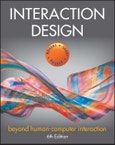Effective and engaging design is a critical component of any digital product, from virtual reality software to chatbots, smartphone apps, and more.
In the newly updated sixth edition of Interaction Design: Beyond Human-Computer Interaction, a team of accomplished technology, design, and computing professors delivers an intuitive and instructive discussion of the principles underlying the design of effective interactive technologies. The authors discuss how to design and apply digital technologies in the real world, illustrated with numerous examples. The book explores the interdisciplinary foundations of interaction design, including skills from product design, computer science, human and social psychology, and others.
The book builds on the highly successful fifth edition and draws on extensive new research and interviews with accomplished professionals and researchers in the field that reflect a rapidly-changing landscape. It is supported by a website hosting digital resources that add to and complement the material contained within.
Readers will also find: - Explorations of the social and emotional components of interacting with apps, digital devices and computers - Descriptions about how to design, prototype, evaluate and construct technologies that support human-computer interaction - Discussions of the cognitive aspects of interaction design, as well as design and evaluation, including usability testing and expert reviews.
An essential text for undergraduate and graduate students of human-computer interaction, interaction design, software engineering, web design, and information studies, Interaction Design will also prove to be indispensable for interaction design and user experience professionals.
Table of Contents
What’s Inside xix
1 What Is Interaction Design? 1
1.1 Introduction 1
1.2 Good and Poor Design 3
1.3 Switching to Digital 6
1.4 What to Design 8
1.5 What Is Interaction Design? 10
1.6 People-Centered Design 14
1.7 Understanding People 16
1.8 Accessibility and Inclusiveness 17
1.9 Usability and User Experience Goals 20
Further Reading 32
Interview with Harry Brignull 34
2 The Process of Interaction Design 37
2.1 Introduction 37
2.2 What Is Involved in Interaction Design? 38
2.3 Some Practical Issues 55
Further Reading 66
3 Conceptualizing Interaction 69
3.1 Introduction 69
3.2 Conceptualizing Interaction 72
3.3 Conceptual Models 75
3.4 Interface Metaphors 79
3.5 Interaction Types 81
3.6 Paradigms, Visions, Challenges, Theories, Models, and Frameworks 89
Further Reading 96
Interview with Albrecht Schmidt 97
4 Cognitive Aspects 101
4.1 Introduction 101
4.2 What Is Cognition? 102
4.3 Cognitive Frameworks 124
Further Reading 134
5 Social Interaction 135
5.1 Introduction 135
5.2 Being Social 136
5.3 Face-to-Face Conversations 141
5.4 Remote Collaboration and Communication 147
5.5 Co-Presence 159
5.6 Social Games 165
Further Reading 169
6 Emotional Interaction 171
6.1 Introduction 171
6.2 Emotions and Behavior 172
6.3 Expressive Interfaces: Aesthetic or Annoying? 180
6.4 Affective Computing and Emotional AI 184
6.5 Persuasive Technologies and Behavioral Change 189
6.6 Anthropomorphism 192
Further Reading 196
7 Interfaces 199
7.1 Introduction 199
7.2 Interface Types 200
7.3 Natural User Interfaces and Beyond 266
7.4 Which Interface? 267
Further Reading 269
Interview with Leah Buechley 271
8 Data Gathering 273
8.1 Introduction 273
8.2 Six Key Issues 274
8.3 Capturing Data 281
8.4 Interviews 284
8.5 Questionnaires 294
8.6 Observation 302
8.7 Putting the Techniques to Work 315
Further Reading 322
9 Data Analysis, Interpretation, and Presentation 325
9.1 Introduction 325
9.2 Quantitative and Qualitative 327
9.3 Basic Quantitative Analysis 330
9.4 Basic Qualitative Analysis 340
9.5 Analytical Frameworks 350
9.6 Tools to Support Data Analysis 362
9.7 Interpreting and Presenting the Findings 362
Further Reading 368
10 Data at Scale and Ethical Concerns 371
10.1 Introduction 371
10.2 Approaches for Collecting and Analyzing Data 373
10.3 Visualizing and Exploring Data 388
10.4 Ethical Design Concerns 398
Further Reading 405
11 Discovering Requirements 407
11.1 Introduction 407
11.2 What, How, and Why? 408
11.3 What Are Requirements? 409
11.4 Data Gathering for Requirements 418
115. Bringing Requirements to Life: Personas and Scenarios 426
11.6 Capturing Interaction with Use Cases 436
Further Reading 440
12 Design, Prototyping, and Construction 441
12.1 Introduction 441
12.2 Prototyping 443
12.3 Conceptual Design 456
12.4 Concrete Design 467
12.5 Generating Prototypes 470
12.6 Construction 480
Further Reading 486
Interview with Jon Froehlich 487
13 Interaction Design in Practice 491
13.1 Introduction 491
13.2 AgileUX 494
13.3 Design Patterns 504
13.4 Open Source Resources 510
13.5 Tools for Interaction Design 512
Further Reading 514
Interview with Luciana Zaina 515
14 Introducing Evaluation 519
14.1 Introduction 519
14.2 The Why, What, Where, and When of Evaluation 520
14.3 Types of Evaluation 524
14.4 Evaluation Case Studies 533
14.5 What Did We Learn from the Case Studies? 541
14.6 Other Issues to Consider When Doing Evaluation 543
Further Reading 547
15 Evaluation Studies: From Controlled to Natural Settings 549
15.1 Introduction 549
15.2 Usability Testing 550
15.3 Conducting Experiments 564
15.4 In- the- Wild Studies 567
Further Reading 576
Interview with danah boyd 577
16 Evaluation: Inspections, Analytics, and Models 583
16.1 Introduction 583
16.2 Inspections: Heuristic Evaluation and Walk-Throughs 584
16.3 Analytics and A/B Testing 601
16.4 Predictive Models 610
Further Reading 614
Epilogue 615
References 619
Index 675








